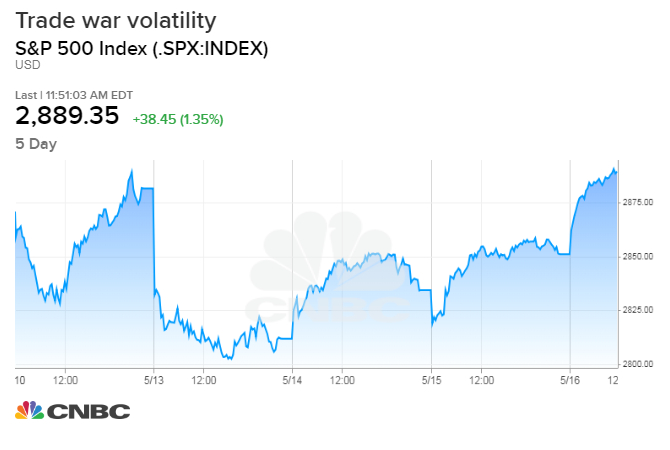
Several months ago, pharmacy technician Curtis Webb thought his credit score was high enough to help him snag good terms on a mortgage.
“It was close to 730. I thought it would help me get a good interest rate,” said Webb, 27, a Utah resident. “Then the lender came back with my actual score. I was shocked.”
The underwriter had checked his “classic” FICO score, which was more than 40 points lower than the score that he’d been monitoring online. The lower score meant a higher interest rate, making the loan a more expensive prospect.
Curtis Webb, a pharmacy technician and student at the University of Utah, holds his 18-month-old son, Callahan.
Source: Curtis Webb.
That scenario is common, experts say. Consumers can retrieve a credit score online that may not be the one that’s used when they actually apply for a loan. And while the discrepancy might not always be significant — or could be in your favor — some industry watchers say the differences are confusing at best and misleading at worst.
“Consumers don’t even know what score they’re looking at, or if it’s the one used by lenders,” said Al Bingham, a credit expert and author of “The Road to 850.”
“In most cases, it’s not,” he said.
The credit-scoring world is a complex one, despite many consumers thinking their score is a number that is the same — or at least very similar — no matter where it’s presented.
“It’s unrealistic to expect that a number, whether from a website or credit bureau or anywhere else, will be the same number that some future lender is going to use,” said John Ulzheimer, a credit expert and president of The Ulzheimer Group in Atlanta. “If it is identical, chalk it up to luck.”
FICO scores are considered the most widely used numbers in lending decisions across consumer loans and lines of credit. The company says its scores are used in 90% of lending decisions, based on data audited by a third party.
VantageScore, meanwhile, says that 2,800 organizations (including 2,500 financial institutions) used close to 10.5 billion of its scores from July 2017 through June 2018, based on a study by global consulting firm Oliver Wyman. Most of that usage, though, came from credit card companies managing existing credit card accounts and prescreening applicants.
Webb, the Utah resident, had been monitoring his score on personal finance website Credit Karma, which provides scores from the VantageScore model. That’s a joint venture among the nation’s three biggest credit-reporting firms: Experian, Equifax and TransUnion.
The VantageScore was created in 2006 as a competitor to FICO, which has been around since 1989. Both brands use similar data to compute your number — including things like outstanding debt, payment history and other financial tidbits that help predict whether you’ll repay what you borrow. The most familiar versions of both VantageScore and FICO result in a score that falls on a scale of 300 to 850.
It’s unrealistic to expect that a number, whether from a website or credit bureau or anywhere else, will be the same number that some future lender is going to use.
John Ulzheimer
President of The Ulzheimer Group
However, the specific algorithms used to arrive at your numbers are different. And both brands have multiple versions — upgraded editions, often — which also contribute to variations in the scores that you see. Even the credit-reporting companies can provide same-named scores that differ from one to the next due to differences in the information reported to them or the timing of it.
Of course, regardless of the score lenders choose to use, they also typically weigh additional items including income, length of employment, stable housing or other aspects of your financial life that don’t show up in your credit report or get reflected in your score.
Yet as many consumers know, the higher your score, the better terms you can get on loans and credit cards, including the interest rate — which can save a lot of money in interest over the life of a loan.
For example, a $ 160,000 mortgage paying 4% over 30 years incurs $ 115,280 in interest. Just a half percentage point higher, 4.5%, would yield $ 132,128 in interest over the same time — $ 16,848 more.
FICO Score Factors:
Most influential: Payment history on loans and credit cards
Highly influential: Total debt and amounts owed
Moderately influential: Length of credit history
Less influential: New credit and credit mix (the types of accounts you have)
VantageScore Factors:
Most influential: Payment history
Highly influential: Age and type of credit, percent of credit limit used
Moderately influential: Total balances and debt
Less influential: Recent credit behavior and inquiries, available credit
Source: Experian
Consumers often see the biggest discrepancy in scores when they apply for a mortgage, experts say.
Fannie Mae and Freddie Mac, the largest purchasers of home mortgages on the secondary market, rely on a consumer’s classic FICO score. As such, lenders generally follow their guidelines to ensure their loans can be resold to investors. Some critics say the two government-sponsored enterprises should be able to use updated scoring models, such as VantageScore.
In December, the Federal Housing Finance Agency issued a rule proposal to allow Fannie and Freddie to employ alternative models, but it would ban them from using one that is owned in part by the company providing the number — which would eliminate VantageScore due its ownership by the three largest credit-reporting companies (which provide the scores that end up at Fannie and Freddie). It’s uncertain how that will shake out.
More from Personal Finance:
Here are the best and worst jobs of 2019
First-time moms see a 30% drop in pay
Retirees are flocking to these ‘hot’ spots
A VantageScore spokesman said the important thing is for consumers to pay attention to their number and whether it’s improving or getting worse.
“If you’re monitoring your score, that’s a good thing,” said Jeff Richardson, a VantageScore spokesman. “And, VantageScore is directionally accurate and similar to other scores that will be used future lending decisions.”
Whether it’s similar or not, it does come with an advantage: Consumers can access it for free.
Discovering a FICO score that a lender plans to use can mean paying for it, although nonprofit credit-counseling firms are able to provide it at no cost. Lenders also are required to tell you the score they used in their decision if you are either denied a loan or credit, or are offered less favorable terms than other consumers get.
Weekly advice on managing your money
Get this delivered to your inbox, and more info about about our products and services.
By signing up for newsletters, you are agreeing to our Terms of Use and Privacy Policy.
.investigation-wrapper .description{ text-align:center; padding-bottom:15px; } .nl-privacy{ font-size: 10px; padding-top: 20px; display:block; } .wildcard .investigation-wrapper { -webkit-box-shadow: 0px 0px 4px 0px #999999; /* Android 2.3+, iOS 4.0.2-4.2, Safari 3-4 */ box-shadow: 5px 5px 5px 0px #999989; } .subsection .investigation{ background: #efefef; border-radius: 3px; padding: 10px 20px 20px 20px; } .investigation small{white-space:normal;} .subsection .investigation h1{ text-transform: uppercase; text-align: center; font-family: “Gotham Narrow Ssm 5r”; margin-bottom: 0px; padding-bottom:0px; font-size: 18px; margin-top: 10px; word-spacing: 1.5px; color: #333333; } .subsection .investigation .headline_title { font-size: 28px; padding-top: 20px; display: block; font-family: “Gotham Narrow Ssm 7r”; padding-bottom:5px; } .subsection .email-info { background: rgba(74, 144, 226, 1); max-width: 140px; margin: 0px auto; text-align: center; padding: 6px 1px; color: #fff; border-radius: 5px; } .subsection .email-info { color:#fff; } .subsection .email-info:hover{ background: #2077B6; } body .subsection.investigation-wrapper{overflow:visible;}
MyFico.com, where you can see all of your FICO scores, charges from about $ 20 to $ 40 monthly, depending on the level of credit monitoring you sign up for. And while FICO has partnered with some banks and lenders to share specific FICO scores with customers, another loan company might use an entirely different version in their decision-making.
For Webb, the Utah resident, the difference in scores meant that he and his wife had to revise their plans. Instead of buying an existing home, they plan to purchase a new house that won’t be ready for another nine months or so. Webb hopes to improve his score between now and then so he can lock in the best interest rate possible before they go to settlement.
Soon after Webb’s disappointing experience, the disparity in his scores was explained to him in a personal finance class at the University of Utah, where he’s working on both a bachelor’s degree in human family and community development, and a certified financial planner designation.
Bingham, the credit expert, was there as a classroom guest to explain to students the differences among credit scores.
“It was eye-opening for me,” Webb said.
If you can get your score for free but it’s not accurate, what’s the purpose?
Al Bingham
Author of “Road to 850”
The class instructor, Anne House, said consumer misconception about credit scores is rampant.
“There is so much confusion surrounding this,” said House, who also is the director of the university’s Personal Money Management Center.
“I have pretty savvy students, but even they get confused when we talk about credit scores and credit reports, let alone when we explain the different scores we can get,” House said.
For its part, Credit Karma does provide information on the differences between credit scores on its website. And in emailed comments to CNBC, a Credit Karma vice president, Dana Marineau, said it’s “unlikely that a consumer will get the same credit score that his or lender is using at the time of a loan application.”
“Credit Karma recommends people choose one credit score source to track to understand its status and how it trends — and should never pay for their scores,” Marineau said.
Nevertheless, some experts question how helpful it is to provide a credit score if it’s unlikely to be the one used the next time you apply for a loan or credit.
“If you can get your score for free but it’s not accurate, what’s the purpose?” Bingham said.






